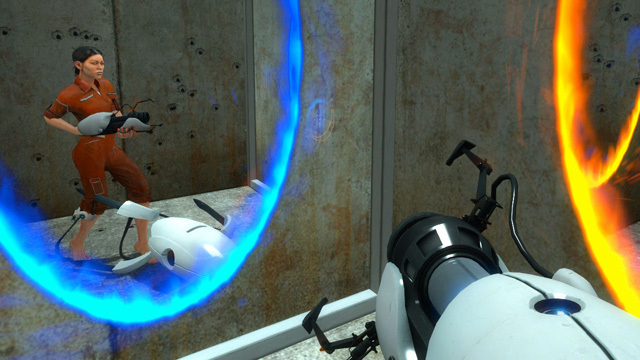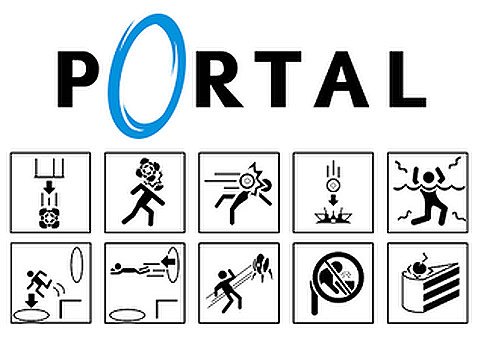Sucked in

This is not a post about Portal 2, even though I’ve been playing the game so much that my wife has started to make cracks about me loving the game more than her. (It’s not true, just in case you’re wondering. I’ve been chasing trophies in the single-player game while I wait for the PSN co-op mode to come back up. Or to get someone to use my second controller here. Maybe my wife. . .)
No, I’m going talk about the first Portal, released for the PS3 as part of The Orange Box in 2007. It’s kind of hard to track down in that form these days, even though the XBox version is $20, and everywhere. If you can’t track it down for your PS3, you can play it on Steam, VALVEe’s online gaming community on your Mac or PC.

If you’ve ever played the original Portal, Portal 2 makes total sense. Portal 2 gives you new puzzle pieces, and larger, more varied environments, but it does such an incredible job of building a rich, multilayered world using the same tools as the original Portal, that it’s easy to forget how unique and engagingly odds those tools were the first time around.
Portal initially presents itself as a perfectly transparent environment. You wake up in a glass cube, and you are instructed to enter a series of chambers where you use a portal gun and a number of environmental objects to solve twenty spacial/sequential puzzles. You’re told at the beginning where the endpoint is going to be—with the exception of the first “00” chamber, each test chamber is numbered 1/19, 2/19, etc.
Until, of course, the whole thing goes off the rails. GLaDOS, the malevolent artificial intelligence whose voice guides and taunts you in turns, is actually trying to kill you. (There are hints throughout the game that she’s done this before.) The final puzzle ends with a platform slowly lowering itself into molten metal. After escaping from this deathtrap, you have to find your way through the machinery behind the puzzle rooms and eventually to GLaDOS herself, whom you have to destroy.
There are a number of ways of looking at Portal. It’s a wildly entertaining puzzle game. It’s the most subversive first-person shooter ever created. It’s a master class on game design which leads you forward on a specific path while persuading you that you’ve found the way yourself. I’d like to argue, however, that Portal is a remarkable illustration of the distinction (in video games) between architecture and genre, and the results that are possible when you exploit and break down genre conventions.

Sorting Portal into a specific genre is a bit tricky. While the game is built on a first-person shooter engine (much like VALVe’s Half Life series), it’s really impossible to describe the game itself as a first-person shooter. You don’t really have a gun. There are almost no enemies to be killed, and the dangers you face are largely environmental—water hazards, physical obstacles that will push you off of moving platforms, and stationary turrets that will shoot you on sight but will shut down if you simply knock them over. In fact, Portal is constructed as a puzzle game where the world explodes at the end. After twenty increasingly complex discrete environments, you “escape” into space. You climb rusty stairs and squeeze between heavy machinery. It’s no longer clear where the endpoint will be. At times it seems that GLaDOS can see you, and at times you appear to be undetectable. You keep trying to move forward, although from time to time you have to stop to figure out where exactly forward is.
The twenty-first “escape” level is by far the longest level in Portal, although it’s still clearly designed to be completed in a single session. When I played for the first time, you couldn’t have convinced me to turn it off. My heart raced, and I’m a bit ashamed to say that for the first time in the game I resorted to some online guides when I couldn’t quite figure out what to do next. I didn’t want to stop and save and think. I had to keep running. I didn’t feel safe in any particular spot, not usually because of any direct, impending danger, but because I suddenly had no idea of what would happen next. I knew I was headed toward a confrontation with GLaDOS, but I didn’t have any idea what I could possibly use as a weapon. While I loved all the puzzle levels, and imagined myself writing an article about how the game largely removed itself from time—that is, most of the puzzles aren’t based on reflexes so much as figuring out how to use a tool to solve a problem—but the final level creates a compelling sense of urgency, largely because of the idyllic timeless abstraction of the earlier levels.
Which, in the end, is Portal‘s big secret. It’s not a first-person shooter. It’s not a puzzle game where the world explodes at the end. If you take the narrative seriously, Portal is actually a single-level game with a clever twenty-stage tutorial. Portal 2 reinforces this. While there are recognizable puzzle levels—and part of the fun of Portal 2 is the way that aesthetics, the different “skins” that are draped over the same wire-frame 3D architecture are used to convey time, setting, and story—the puzzle levels exist to teach you how to use the increasing variety of tools that you need to use to navigate the spaces between worlds. Even more so, the puzzles themselves exist within the worlds this time, giving you more frequent opportunities to peek outside, and occasionally to move in and out of the puzzle spaces.
And it’s all built on a single fascinating twenty-stage tutorial.
—
Gavin Craig is co-editor of The Idler. You can follow him on Twitter at @craiggav.
Comments
One Response to “Sucked in”Trackbacks
Check out what others are saying...[…] game with the narrative techniques of the classic 2D RPG. (That is, it’s another example that game architecture isn’t determinative of genre.) The game uses platform mechanics to allow the player to navigate the world, but RPG mechanics to […]